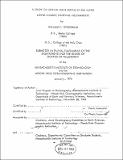A study of certain trace metals in sea water using anodic stripping voltammetry
Author(s)
Fitzgerald, William Francis, 1926-
DownloadFull printable version (7.216Mb)
Other Contributors
Woods Hole Oceanographic Institution.
Advisor
Derek W. Spencer and David N. Hume.
Terms of use
Metadata
Show full item recordAbstract
Anodic stripping voltammetry utilizing a thin film mercury composite graphite electrode has been evaluated and applied for the direct analysis of the metals, Zn,J Cu, Pb, and Cd in sea water. The electrode was observed to follow theoretical behavior for thin film electrodes and the technique was found not to be adversely affected by dissolved organic material in sea water. Good precision (ca., 5%) was obtained in both coastal and open ocean waters at the in situ concentrations of Zn, Cu, Pb, and Cd. It was shown that this method is at present most suitable for measurements of Cu, Pb, and Cd in sea water. Evidence is given suggesting that Ni may interfere with the determination of Zn through formation of an intermetallic compound, and further studies are indicated to understand this phenomenon. The anodic stripping apparatus was adapted and used conveniently on shipboard. It was demonstrated that stripping analysis could be combined with a method for the destruction of dissolved organic matter- (photo-oxidation with ultra-violet radiation), and with an acidification procedure to obtain measurements of trace metal speciation in sea water. (cont.) An argument for the existence of Cu-aspartic acid chelates in sea water has been described theoretically and demonstrated empirically; suggesting that a significant fraction of Cu and other trace metals may be expected to be organically sequestered in sea water. A study of coastal waters employing the total method (anodic stripping-photo-oxidation-acidification) indicated the presence of a significant group of organic ligands that complex Cu (ca., 60%). It was also shown that the waters subject to gross pollution contain about 30% of the total Cu in very stable organic complexes that release Cu only when the dissolved organic matter is destroyed, and not when the pH of this sea water is adjusted to 3. An open ocean trace metal study of a thermal-front zone in the western Sargasso Sea gave data for Cu, Zn, Pb, and Cd that compared favorably with other relevant investigations. Higher free metal concentrations were observed south of the front than to the north, providing further evidence that these fronts may mark a change between southern and northern conditions in the Sargasso Sea. Data obtained from shipboard analyses using the total analytical method indicates the presence of weak organic complexes with Cu and Pb in open ocean waters.
Description
Thesis (Ph. D.)--Joint Program in Oceanography (Massachusetts Institute of Technology, Dept. of Earth and Planetary Sciences; and the Woods Hole Oceanographic Institution), February 1970. "January 1970." Includes bibliographical references (p. 173-177).
Date issued
1970Department
Joint Program in Oceanography; Woods Hole Oceanographic Institution; Massachusetts Institute of Technology. Department of Earth, Atmospheric, and Planetary SciencesPublisher
Massachusetts Institute of Technology
Keywords
Joint Program in Oceanography., Earth and Planetary Sciences., Woods Hole Oceanographic Institution.